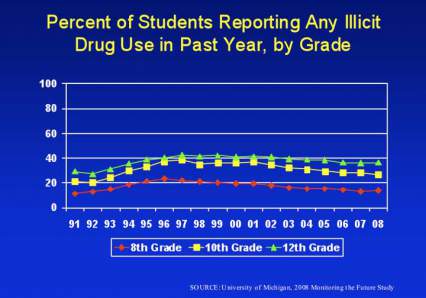The Good News
- From 2007 to 2008, the percentage of 10th graders reporting lifetime, past year, and past month use of any illicit drug other than marijuana declined significantly. Lifetime use decreased from 18.2% to 15.9%, past year use declined from 13.1% to 11.3%, and past month use decreased from 6.9% to 5.3%.
- Cigarette smoking continues to fall to the lowest rate in the survey's history. Between 2007 and 2008, declines were observed in lifetime, past month, and daily cigarette use among 10th graders. Although there were no 1-year declines for 8th and 12th graders, all grades have continued a longer term trend of declining cigarette use. 1
- Overall, the use of stimulants declined: lifetime, past year, and past month amphetamine use declined among 10th graders. Crystal methamphetamine (i.e., Ice) use continues to decline - past year use fell among 12th graders, from 1.6% to 1.1%. Also, past year crack cocaine use declined from 2007 to 2008 among 12th graders, from 1.9% to 1.6%.
- The use of alcohol in all prevalence periods measured among 10th graders decreased. For example, past year alcohol use by 10th graders declined from 56.3% in 2007 to 52.5% in 2008.
Areas of Concern
- Marijuana use across the three grades has shown a consistent decline since the mid-1990s, but appears to have leveled off. Past year use was reported by 10.9% of 8th graders, 23.9% of 10th graders, and 32.4% of 12th graders.
- In 2008, 15.4% of 12th graders reported using a prescription drug nonmedically within the past year.2 Vicodin continues to be abused at unacceptably high levels. Many of the drugs used by 12th graders are prescription drugs or, in the case of cough medicine, are available over the counter (see figure).
- Attitudes toward substance abuse, often seen as harbingers of change in use rates, were mostly stable. However, among 12th graders, perceived risk of harm associated with LSD continues to decrease. Additionally, perceived harmfulness and disapproval of marijuana and inhalant use softened among 8th graders this year.
The images above and additional information are available to download - MTF2008Posters.pdf (PDF, 52 Kb)
Notes:
1. These findings are particularly noteworthy since tobacco addiction is one of the leading preventable contributors to many of our Nation's health problems.
2. This category includes amphetamines, sedatives/barbiturates, tranquilizers, and opiates other than heroin.


